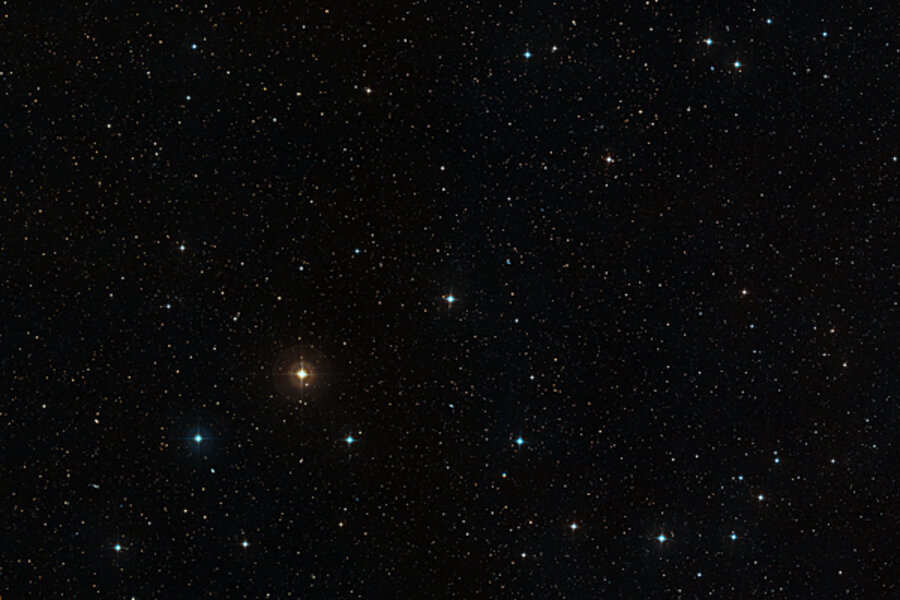Oddball solar system found: Six giants and an exoplanet pipsqueak?
Loading...
Imagine the sun hosting five Neptune-like planets, all sprinkled between the orbit of Mars – some 139 million miles from the sun – and a mere 6 million miles from the sun.
That gives a pretty good mental image of the oddball solar system astronomers have just discovered.
It not only presents a configuration of planets no one has seen before (though one comes close), it also may host the smallest extra-solar planet yet discovered.
If more systems like this turn up, they could test scientists' theories of how planetary systems form, researchers say.
"We are now entering a new era in exoplanet research: the study of complex planetary systems, not just of individual planets," said Christophe Lovis, an astronomer at the University of Geneva's Geneva Observatory in Versiox, Switzerland, who led the research team.
The discovery, announced Tuesday, involves a star 127 light-years from Earth in the constellation Hydrus. It hosts five planets with masses ranging from 12 to 25 times the Earth's mass. The outermost orbits the host star, HD 10180, at a distance of 130 million miles – or 1.4 astronomical units (with one AU being the distance between the Earth and the sun).
But the team reporting the results also says its evidence suggests a sixth planet, with 64 times Earth's mass, orbiting the star at a distance comparable to the far edge of our solar system's main asteroid belt, between Mars and Jupiter. The team also suggests a seventh planet, only 1.4 times Earth's mass, orbiting the star at just under 2 million miles away – one hot rock.
The solar system's innermost planet, Mercury, is 36 million miles from the sun.
Planet formation mysteries
Based on what researchers have gleaned about the process of planet formation, it's not impossible to imagine a system that forms five Neptune-like planets, which wind up in the orbits these new planets inhabit, says Scott Kenyon, who studies star and plant formation at the Harvard-Smithsonian Center for Astrophysics in Cambridge, Mass.
"But it's not easy," he says.
The team, which includes scientists from nine European research facilities, used the 3.6-meter telescope at the European Southern Observatory's facility in La Silla, Chile, and a spectrograph named HARP, to monitor HD 10180 for signs of planets. The signs: tell-tale wobbles in the star's spectra as planets' gravity tug on the star as the planets orbit.
It took six years to gather the 190 observations needed to make the discovery.
The team estimates the age of the star, and hence its planetary system, at some 4.3 billion years old, just 300 million years younger than our solar system.
The HD 10180 system's formation remains a puzzle.
How did the planets get there?
The team notes that it's unlikely the planets formed in their current locations. The dust disks around stars from which planets form – at least disks observed so far – don't contain enough material at around 1 AU to form the troupe the European team found.
The alternative is the usual explanation for such massive planets: that they formed outside the system's so-called frost line – the general boundary beyond which water vapor and other gases in the primordial disk condense directly into ice grains – as they have in our solar system. Then they migrated inward.
But if that was the case in the HD 10180 system, it's hard to see how they could perform a neat bit of formation flying to all migrate toward the star together, while at the same time accumulating the large masses they now display.
"This is sort of a Goldilocks kind of thing," Dr. Kenyon explains. The mass in the primordial disk has only three broad places it can go, or "sinks": some of the mass falls onto the star, some of it evaporates when photons from the star smack it, and some of the mass forms planets.
If those three factors are "balanced just right, you could imagine making a bunch of Neptunes, and then the disk goes away," so there's not quite enough mass left to make these become larger Jupiter-like planet, Kenyon says. For all the advancements in understanding solar system formation, "we still don't know how all of these sinks work off one another."
"This kind of a system, and others like it if they can find them, will really provide a test" for theories about how primordial disks around stars evolve to form planets, he says.





